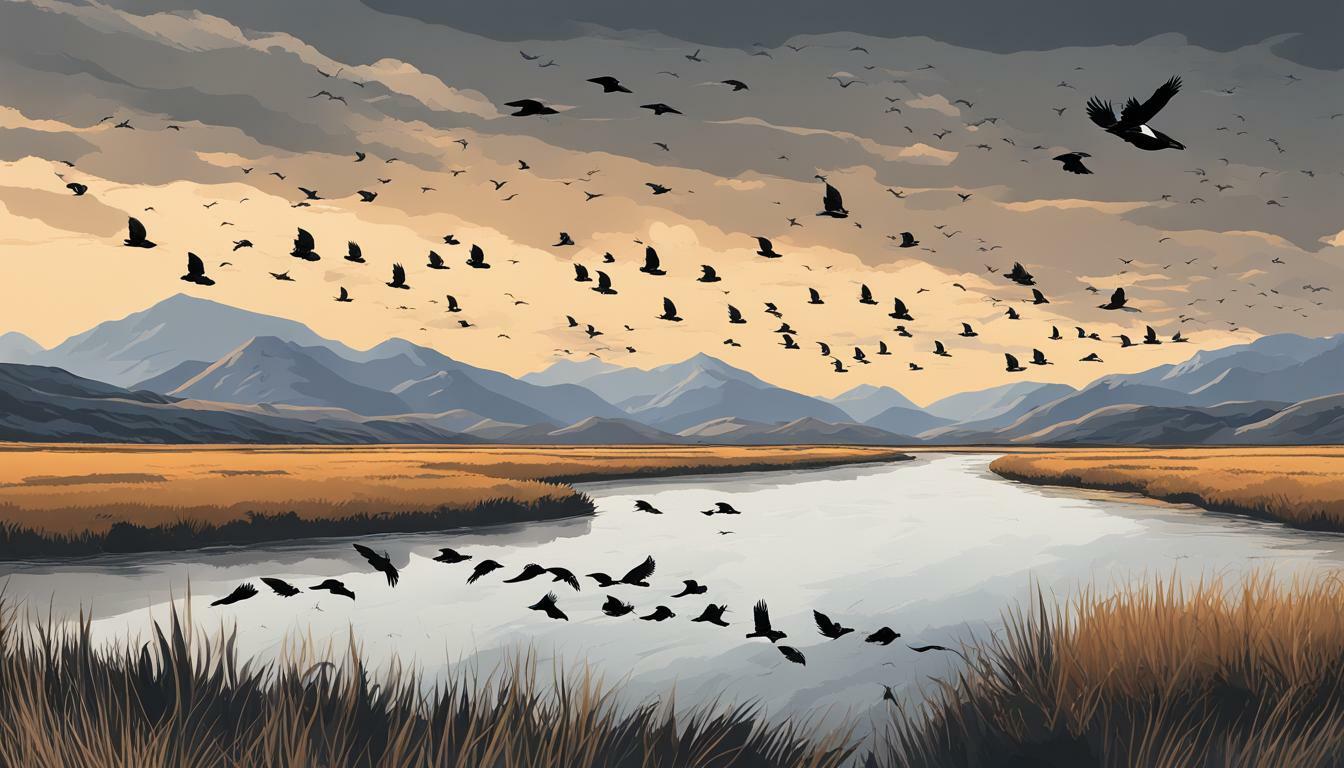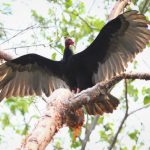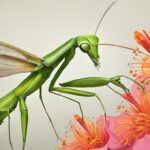Have you ever wondered whether crows migrate? These intelligent birds are a common sight in many parts of the world, but their migratory habits remain a mystery to many. In this section, we will explore the fascinating topic of crow migration and their behavior in the wild.
Despite being a common sight in many urban areas, crows are also found in a variety of natural habitats. Known for their intelligence and adaptability, crows have been observed exhibiting complex social behaviors in the wild.
Key Takeaways
- Crows are common in both urban and natural environments
- The migratory habits of crows are often mysterious to many
- Crows are intelligent and exhibit complex social behaviors in the wild
Understanding Crow Migration
Crows are known for their interesting migration patterns, which are both seasonal and regular. As with many bird species, the timing and routes of their migration depend on a variety of factors, including changes in weather patterns, the availability of food, and breeding cycles.
Like many birds, crows tend to migrate in the spring and fall. During the spring migration, they typically move from their wintering grounds in southern regions to more northern areas for breeding and nesting. In the fall, they reverse the process and head back south for the winter.
Crow migration routes can vary depending on the specific population of crows. In general, crows tend to follow similar routes year after year, using familiar landmarks and geographical features to guide their way. Scientists have been able to track some of these routes using GPS technology and satellite imagery.
Migratory Patterns of Crows
Crow migration patterns can vary depending on the local climate and environmental conditions. In some regions, crows may stay in one area year-round if there is an ample food source available. However, in areas with harsher winters or limited food options, crows may migrate to escape the cold or find better food sources.
One interesting thing about crow migration is that not all birds in a population may migrate. Some individuals may stay in one area year-round, while others may migrate only when necessary. This can be due to a variety of factors, including age, health, and breeding status.
Seasonal Migration of Crows
As with many migratory bird species, the timing of crow migration is closely tied to the changing seasons. In the spring, crows may begin their migration as early as February in some regions, while in others they may not start moving until April or May.
In the fall, the timing of migration can also vary depending on the local climate. Crows in northern regions may start their migration as early as September, while those in more southern regions may not start moving until November or December.
Crow Migration Routes
The routes that crows take during their migration can vary depending on a variety of factors. In general, crows tend to follow the same routes year after year, using landmarks and geographical features to guide their way.
Scientists have been able to track some of these routes using GPS technology. In one study, researchers found that crows from a population in the northeastern United States all followed a similar migration path, traveling south through the Appalachian Mountains and along the Gulf Coast before reaching their wintering grounds in the southeastern United States.
Factors Influencing Crow Migration
Crow migration is a complex process that is influenced by various factors. Scientists have been studying these factors for decades to better understand the behavior of these birds. Here are some of the key factors that influence crow migration:
| Factor | Description |
|---|---|
| Food Availability | Crows tend to migrate to areas where food is abundant, such as fields and forests that have large insect populations or crops that have just been harvested. They also migrate away from areas that have experienced drought or other environmental factors that have reduced food availability. |
| Weather Conditions | Weather plays a crucial role in crow migration. Crows tend to migrate when the temperatures begin to drop in the fall, and they return to their breeding grounds when the weather starts to warm up in the spring. They also tend to avoid flying during heavy rain or strong winds, as it can be dangerous and difficult to navigate. |
| Day Length | As with many bird species, the length of the day is a key factor in crow migration. Crows tend to migrate when the days start to get shorter in the fall, and they return to their breeding grounds when the days start to get longer in the spring. |
| Geomagnetic Cues | Another factor that influences crow migration is the Earth’s magnetic field. Scientists have found that crows can detect changes in the Earth’s magnetic field and use it to navigate during migration. They may also use visual landmarks and the position of the sun to orient themselves. |
Scientists have been able to track crow migration using a variety of techniques, including bird banding and satellite tracking. Bird banding involves attaching a small metal band to a bird’s leg that contains a unique identifier, allowing scientists to track its movements. Satellite tracking involves fitting a bird with a lightweight GPS device that can transmit data on the bird’s location and migratory route.
By understanding the various factors that influence crow migration and how scientists track their movements, we can gain a greater appreciation for the complexity of this natural phenomenon.
How Do Crows Migrate?
Unlike some species of birds that migrate in large flocks, crows tend to migrate in smaller groups or even individually. However, multiple studies have shown that crows do follow specific migration patterns during certain times of the year. So how do crows migrate?
One factor that influences crow migration is food availability. Crows will migrate to areas where they can find a plentiful food source. They may also migrate to escape extreme weather conditions, such as harsh winters or excessive heat in the summer.
Scientists track crow migration using a variety of methods, including GPS tracking devices attached to the birds or tracking their movements based on reports from citizen scientists. These tracking efforts have revealed the specific routes that crows take during migration, which often involve flying along coastlines or following major river systems.
During migration, crows typically fly during the day and roost at night. They may also stop at strategic locations to rest and refuel before continuing their journey. Interestingly, crows have been known to follow the same migration routes year after year, indicating that their migration habits are learned behaviors rather than instinctual.
Compared to other species of birds, crows do not have a strong physical adaptation for long-distance flight. However, their intelligence and resourcefulness allow them to navigate and find food along their migratory routes.
In summary, crow migration is influenced by food availability and weather conditions, and scientists have tracked their movements to reveal specific routes and patterns. Despite not having strong physical adaptations for flight, crows demonstrate their intelligence and resourcefulness during migration.
The Fascinating Behavior of Crows in the Wild
Crows are often seen as common birds in urban and suburban areas, but their behavior in the wild is far more complex and fascinating. As social creatures, crows have a strong sense of community and establish intricate hierarchies within their flocks. They are also highly intelligent birds, known to use tools and solve problems in order to obtain food.
In their natural habitats, crows can be found nesting in trees or other tall structures and foraging for food on the ground. They have a diverse diet, eating everything from insects and small animals to fruits and vegetables. Crows have even been observed stealing food from other birds, such as seagulls and eagles.
Migratory behavior is also a key aspect of crows’ lives in the wild. Depending on the species and location, crows may migrate for a portion of the year to find more favorable conditions for nesting and foraging. They may travel in flocks of thousands, following established migration routes to reach their destinations.
Interestingly, crows are known for their ability to remember and recognize individual humans. They may become aggressive towards those they perceive as threats or sources of food, while showing greater trust and curiosity towards those who have shown kindness.
Overall, the behavior of crows in the wild is a fascinating subject of study for scientists and bird enthusiasts alike. Understanding their habits and migration patterns can provide valuable insights into the broader ecosystems in which they live.
Conclusion
Crow migration is a fascinating and complex phenomenon that scientists are still studying and trying to understand. From the patterns and routes of their travels to the various factors that influence their movements, there is still much we have yet to uncover about these intelligent and resourceful birds.
As we have explored in this article, understanding crow migration is not only important for the sake of scientific discovery, but it also has practical applications. By tracking the movements of crows, we can gain insight into ecological and environmental changes, as well as potential disease outbreaks.
So, the next time you come across a group of crows in the wild, take a moment to appreciate the complexity and beauty of their behavior. By learning more about these amazing birds, we can better protect and preserve their natural habitats for generations to come.
Can Ducks Safely Eat Strawberries or Is It Harmful to Them?
Ducks feeding habits on strawberries can vary. While they can safely eat small amounts, it is important to remember that strawberries should not be a staple in their diet. The high sugar content of strawberries can be harmful to ducks if consumed in large quantities. Moderation is key to ensuring their well-being.
FAQ
Q: Do crows migrate?
A: Yes, crows do migrate. They are known for their seasonal travels, although the extent and distance of their migrations may vary depending on various factors.
Q: What are the patterns and routes of crow migration?
A: Crow migration patterns are influenced by factors such as food availability, weather conditions, and breeding cycles. Crows often follow specific routes during their travels, which may include both short-distance and long-distance flights.
Q: What factors influence crow migration and how is it tracked?
A: Various factors, including food availability, temperature changes, and daylight duration, play a role in crow migration. Scientists track crow movements through methods such as banding, radio telemetry, and satellite tracking.
Q: How do crows migrate compared to other bird species?
A: Crows are known for their adaptability and intelligence, which allows them to navigate and find food during their migratory journeys. They may also travel in large groups called flocks, making their migration behavior unique compared to some other bird species.
Q: How does migration fit into the overall behavior of crows in the wild?
A: Migration is a crucial part of the overall lifestyle of crows in the wild. It helps them find suitable habitat and resources throughout the year, ensures successful breeding, and allows for genetic diversity among populations.











